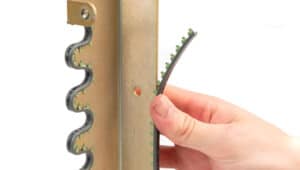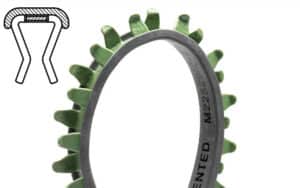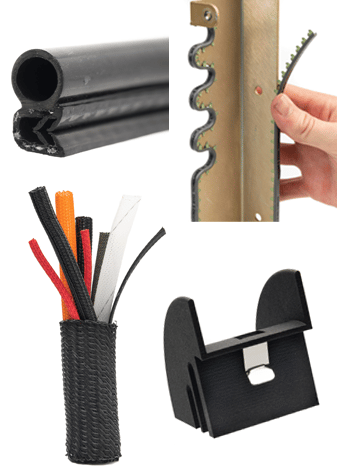Who doesn’t want to cut costs and improve efficiciency? Particularly in these times of supply chain stress, inventory holding costs rising, price increases, and the drive to do more with less as staff shortages bite.
How would you like to cut a cost in half AND do more with less? Impossible you say?
Well, think again. Device Technologies (DTi) has a simple component and process suggestion for any OEM that can save them at least 49% of their install costs and increase task productivity by a factor of 9.5X.
Here’s How DTi Saves OEMs Time & Money:
Switch from the MS21266 nylon grommet edging and its required adhesive – to the higher performance Spring-Fast® M22529/2 grommet edging. It is simply a far better product that offers best-in-class performance.
Grommet edging is a simple product – it protects wiring from chafe. Since the 1940’s the SOP to prevent chafe has been to use a nylon grommet (MS21266) and keep it in place with adhesive. However, this method has inherent issues and switching will create the time and money savings.

How did we come up with 49% & 9.5X?
We worked with clients to create a model that captured the time and costs associated with grommet installation. It might have been called a time and motion study in the past.
It clearly highlights the problems of using nylon grommets and adhesive vs. Spring-Fast. The costs were generated by using a $31.70 shop labor rate which is very conservative and the 9.5X compares the time taken for both processes. Actual savings using your shop labor rate will likely show savings closer to 60%
| MS21266 Nylon | Spring-Fast | |||||
|---|---|---|---|---|---|---|
| Operation | Minutes | Costs | Minutes | Costs | ||
| Sub Operation -Set Up | ||||||
| Batch size for amortization & resulting time/costs | 5 | |||||
| Gather safety equipment fans, mask, gloves, glasses etc | 5 | $2.64 | 0 | $0.00 | ||
| Gather components: grommet, glue, abrasive, tape etc | 5 | $2.64 | 2 | $1.06 | ||
| Total Set Up time/$ | 10 | $5.28 | 2 | $1.06 | ||
| Sub operation amortized time/costs | 2 | $1.06 | 0.4 | $0.21 | ||
| OPERATIONAL STEPS | ||||||
| Amortized batch set up costs (sub op above) | 2 | $1.06 | 0.4 | $0.21 | ||
| Measure edge/penetration & cut to fit | 3 | $1.59 | 3 | $1.59 | ||
| Pre-Fit for size and trim as necessary | 1 | $0.53 | 1 | $0.53 | ||
| Deburr the edge with Scotch-brite/sandpaper | 1 | $0.53 | 0.5 | $0.00 | ||
| Clean metal edge with IPA wipe/MEK | 1 | $0.53 | 0.5 | $0.53 | ||
| Cut 8 pieces of tape for fixturing | 3 | $2.11 | 0 | $0.00 | ||
| Apply adhesive to edge/MS21266 | 5 | $2.64 | 0 | $0.00 | ||
| Apply grommet to edge | 2 | $1.06 | 1 | $0.53 | ||
| Apply masking tape for fixturing | 3 | $1.59 | 0 | $0.00 | ||
| Cure time - 45mins/$0 cost (see assumptions) | 45 | $0.00 | 0 | $0.00 | ||
| Remove masking tape, clean up using MEK | 2 | $1.06 | 0 | $0.00 | ||
| Inspect fit and finish | 1 | $0.53 | 1 | $0.53 | ||
| Labor time/cost | 70 | $13.21 | 7.4 | $3.91 | ||
| 9.5X efficiency gain | ||||||
| Unit Grommet cost (12.75" strip) | $0.35 | $3.00 | ||||
| Install cost per grommet | $13.56 | $6.91 | ||||
| 49% $ Savings | ||||||
| WRAP/Shop Labor rate | $31.70 |
Key Model Assumptions
Time Taken per Step: The time estimates are based on DTi’s years of experience with clients. Your savings & efficiency increase will depend on your WRAP/shop labor rate & the steps taken in your manufacturing process.
Hourly Charge Rate: A $30.70 shop labor rate was used. Almost all OEMs are significantly above that.
Set Up Time: In a non-production line setting, techs have to gather materials & components as a first step. The model assumes grommets are installed in batches of 5 which spreads out the time/cost over 5 grommets.
In this iteration of the model, for nylon, the set-up time is approx. 2 mins per grommet (0.4 mins for Spring-Fast).
If more grommets are installed per set up -say 10- then it will reduce nylon setup time to 1 minute per grommet.
If the grommets are installed in a production line setting -with no setup – this will reduce the set-up time to zero.
Savings Results: These core assumptions yield a remarkable 49% savings. DTi are confident that OEMs will achieve at least 49% savings given the shop labor rate is so low @ $31.70.
Efficiency/Productivity Gain: Based on DTi’s decades of experience, the model shows that a nylon grommet takes 70 mins to install vs 7.4 minutes for Spring-Fast: a 9.5X efficiency gain.
Tech Down Time During Curing: The 70 minutes includes 45 minutes of “labor process time” because the nylon adhesive requires cure time so techs have to leave and return to complete the installation.
Clients tell us this break in production adds ~45 minutes of “labor process time” as techs have to stop, reference new work orders, move to the new job, and then do the same in reverse to complete the grommet install. However, the 45 mins is assumed to be a zero-labor cost because clients tell us their techs go to other jobs. Worst case – if you exclude the 45 minutes- OEMs will achieve at least a 3.4X productivity gain (25mins vs 7.4mins)
Why the Savings Are So Significant
The designed-in features of the M22529/2 grommet drive a far lower direct labor install cost than MS21266
- Snap-in-place installation without adhesive
- Superior retentive strength without adhesive
- Immediate wire/harness routing – no fixturing or cure time delays
An Impact Far Greater Than Its Size
Grommets are small components but their wiring impact is far larger than their size.
They protect wiring from chafe and abrasion. In extreme cases chafe can cause dangerous arcing, sparking, which could lead to fires. However, even before those more dangerous issues, chafe creates widespread problems even at relatively low levels by causing data flow to be disrupted. Even small instances of this can cause in-operation errors and management issues.
Legacy Grommet Issues
Our experience with manufacturers has shown that the legacy glued nylon MS21266 caterpillar grommet has fundamental process issues:
- Preparation and application involve a costly, labor-intensive and multi-step process.
- Multiple items for application & safety have to be gathered in the preparation phase.
- Edge preparation is required: light abrasion with Scotch-Brite and cleaning with IPA or an acetone wipe is needed to ensure proper glue adhesion.
- The MS21266 grommet has no inherent retentive strength or static friction so has to be glued to the penetration using an adhesive.
- In almost all cases, MS21266 requires “fixturing”-securing with masking tape- to hold it in-place until the adhesive cures.
- Any excess adhesive after curing has to be cleaned with a solvent, cloths, and elbow grease.
- A failure to properly bond often means the work has to be redone – adding to the cost of poor quality. Also, over time, the nylon and adhesive are more prone to failure after exposure to heat and moisture.The glued nylon grommet was invented in the late 1940s and while it was state-of-the-art for its time, technology has moved on from this slow, messy, and costly process.
Why M22529/2 Is A Better Choice
- M22529/2 is a high-performance grommet with a polymer coating on an ultra-thin CRES substrate that snaps into place with finger pressure. It has proven its performance across many manufacturing sectors.
- It is a caterpillar-style grommet with opposing finger-like castles that exert a compression force that creates static friction for retention without glue.
- The edge retention -without adhesive- is second to none. It is so good that it easily passed the stringent aerospace-level static load tests for edge retention.

Find out more about Spring-Fast Grommet edging
Request free samples here
Also available through a licensed distributor like Aircraft Spruce

